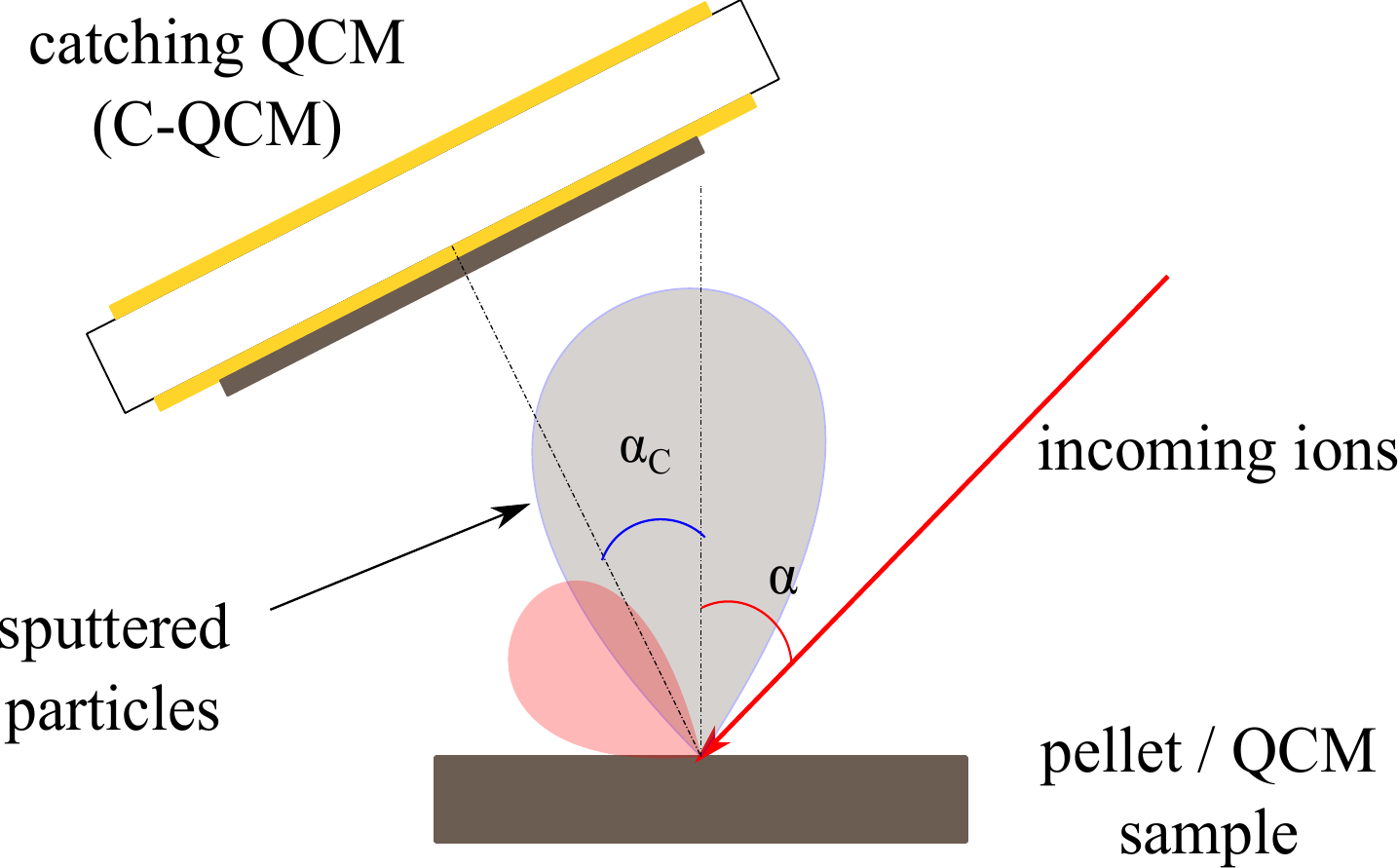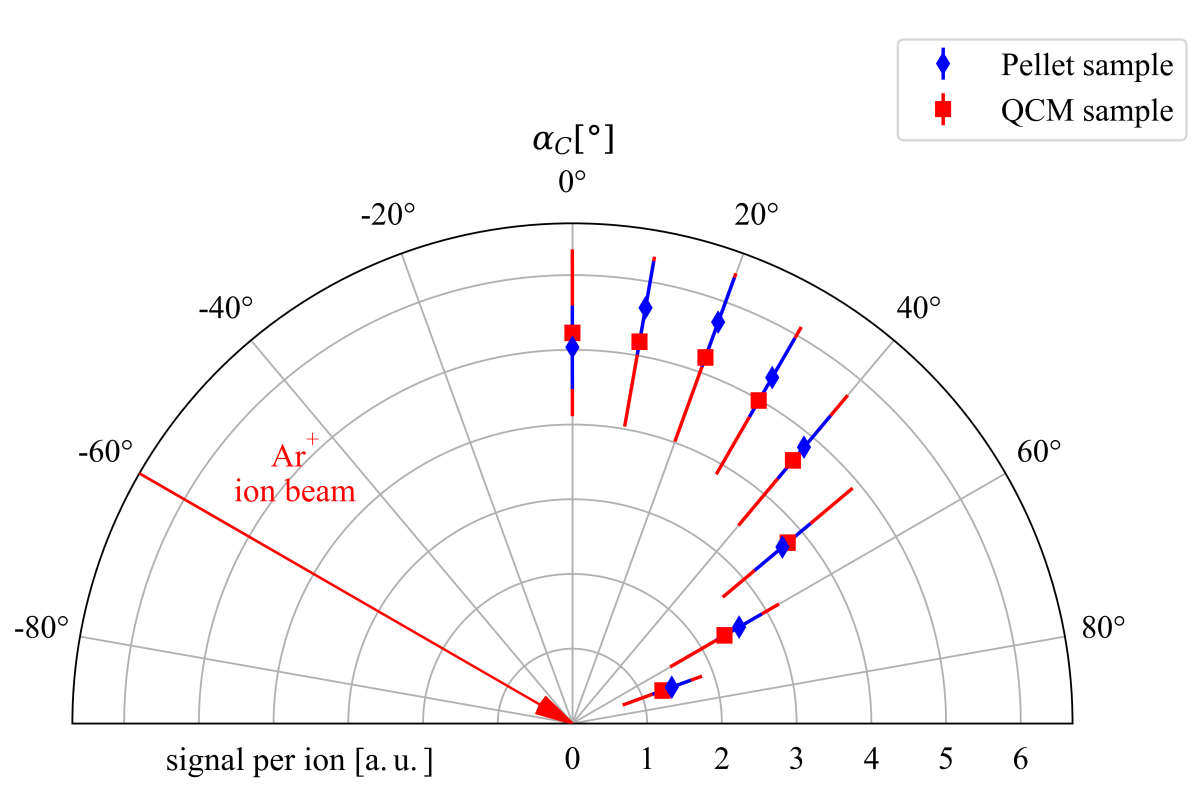Comparing sputtering effects of amorphous films and mineral pellets
- 1Institute of Applied Physics, TU Wien, Vienna, Austria (biber@iap.tuwien.ac.at)
- 2Physics Institute, University of Bern, Bern, Switzerland
- 3Max Planck Institute for Plasma Physics, Greifswald, Germany
- 4Institute of Chemical Technologies and Analytics, TU Wien, Vienna, Austria
- 5Institute of Geological Sciences, University of Bern, Bern, Switzerland
1. Introduction
Ions from the solar wind impinging on airless planetary bodies eject particles from the very surface. Those sputtering processes can also be caused by ions originating from planetary bodies in the direct vicinity. This type of process occurs on the martian moon Phobos, where molecules from the upper atmosphere of Mars are ionized, accelerated and subsequently impact the surface of Phobos [1, 2]. The particles ejected due to ion sputtering typically have an energy of a few eV [3]. For lighter elements, this leads to a significant fraction of them leaving the gravitational field of bodies like Mercury, where an escape velocity of 4.25 km/s corresponds to about 1.5 eV for oxygen [4]. Those particles that are emitted at lower energies are still coupled to the planet‘s gravitational field and contribute to the formation of a so-called exosphere, i.e. a zone with elevated density around airless bodies.
Modeling of the exosphere requires accurate sputtering data as input. A common way of obtaining these data is through the simulation package SRIM, which can provide an estimate for sputtering yields, but is known for its deviations from experimentally obtained values. Improvements can be made by using the SDTrimSP code, but here input parameters have to be set manually to achieve satisfactory agreement with measurements [5]. In both models, amorphous samples are assumed for the simulation and no effects of crystallinity are taken into account. However, these effects can vary from drastic suppression of sputtering due to channeling in single crystals [6] to an increase in sputtering due to linear collision sequences in polycrystalline materials [7].
Experimental investigations of mineral sputtering also mostly use amorphous films [8, 9]. This is due to the use of Quartz Crystal Microbalances (QCM) in sputtering experiments, which allow determining mass changes in the sub-monolayer range in real time and in situ [10]. For experiments with more realistic crystalline minerals however, different approaches have to be used.
2. A novel setup
The new setup for sputtering investigations for minerals at TU Wien is based on catching the material sputtered from samples rather than measuring mass depletion of an irradiated sample [11, 12]. This is accomplished by the use of a QCM in a catching configuration (Figure 1). With this approach, a much wider range of samples can be investigated. Due to the use of two independent rotary manipulators, the angular dependence of the sputtering
processes (variation of α in Figure 1) as well as the angular distribution of sputtered particles (variation of αC ) can be analyzed.

Figure 1: Geometry of the measurements using a QCM to catch sputtered material. Both angles α and αC can be varied independently. Figure taken from [12].
Surface roughness has to be taken into account in sputtering experiments. It has a significant influence on ion sputtering and it is therefore necessary to characterize the surface morphology of irradiated samples in order to derive the correct conclusions [13] . For this purpose, an Atomic Force Microscope is used to precisely map the topography of the irradiated samples surfaces at the nanometer scale.
3. No effects of crystallinity observed
The combination of both a thin wollastonite CaSiO3 based film on a QCM and a pressed wollastonite pellet as samples allows for direct comparison of the signals measured at the catching QCM [14]. Only minor deviations from flat surfaces were expected due to roughness effects. The samples were irradiated with 2 keV Ar+ ions under an angle of incidence of α = 60°. The angular distribution of sputtered particles was analyzed for both samples by varying the catcher angle αC. The signal of the catcher QCM normalized to the ion current is shown in Figure 2. Within measurement uncertainties, no difference in signal per impinging ion was found. This indicates that crystallinity does not have a significant influence on the sputtering of mineral samples, but further measurements are needed for more conclusive statements about the relevance of the materials phase for sputtering effects on celestial bodies like Mercury.
Figure 2: Signal of the catcher QCM per incident ion measured at different catcher QCM angles αC for irradiations with 2 keV Ar+ on wollastonite CaSiO3 at α = 60°.
References
[1] Nenon Q., et al.: J. Geophys. Res. Planets, 124, 3385, 2019.
[2] Szabo P.S., et al.: J. Geophys. Res. Planets, 125, e2020JE006583, 2020.
[3] Betz G., et al.: Int. J. Mass Spectrom., 140, 1, 1994.
[4] Williams, D.R.: Mercury Fact Sheet, 25 Nov. 2020, https://nssdc.gsfc.nasa.gov/planetary/factsheet/mercuryfact.html, (Accessed 17. May 2020).
[5] Szabo, P.S., et al.: Astrophys. J., 891, 100, 2020.
[6] Onderdelingen D.: Appl. Phys. Lett., 8, 189, 1966.
[7] Schlueter K., et al.: Phys. Rev. Lett., 125, 225502, 2020.
[8] Hijazi H., et al.: J. Geophys. Res. Planets, 122, 1597, 2017.
[9] Biber H., et al.: Nucl. Instrum. Methods Phys. Res. B, 480, 10, 2020.
[10] Hayderer G., et al.: Rev. Sci. Instrum., 70, 3696, 1999.
[11] Berger B. M., et al.: Nucl. Instrum. Methods Phys. Res. B, 406, 533, 2017.
[12] Biber H., et al.: EPSC Abstracts, 14, EPSC2020-264, 2020.
[13] Küstner M., et al.: Nucl. Instrum. Methods Phys. Res. B, 145, 320, 1998.
[14] Jäggi N., et al.: Icarus, 365, 114492, 2021.
How to cite: Biber, H., Szabo, P. S., Jäggi, N., Cupak, C., Brötzner, J., Gesell, D., Mutzke, A., Nenning, A., Mezger, K., Galli, A., Wurz, P., and Aumayr, F.: Comparing sputtering effects of amorphous films and mineral pellets, Europlanet Science Congress 2021, online, 13–24 Sep 2021, EPSC2021-526, https://doi.org/10.5194/epsc2021-526, 2021.

